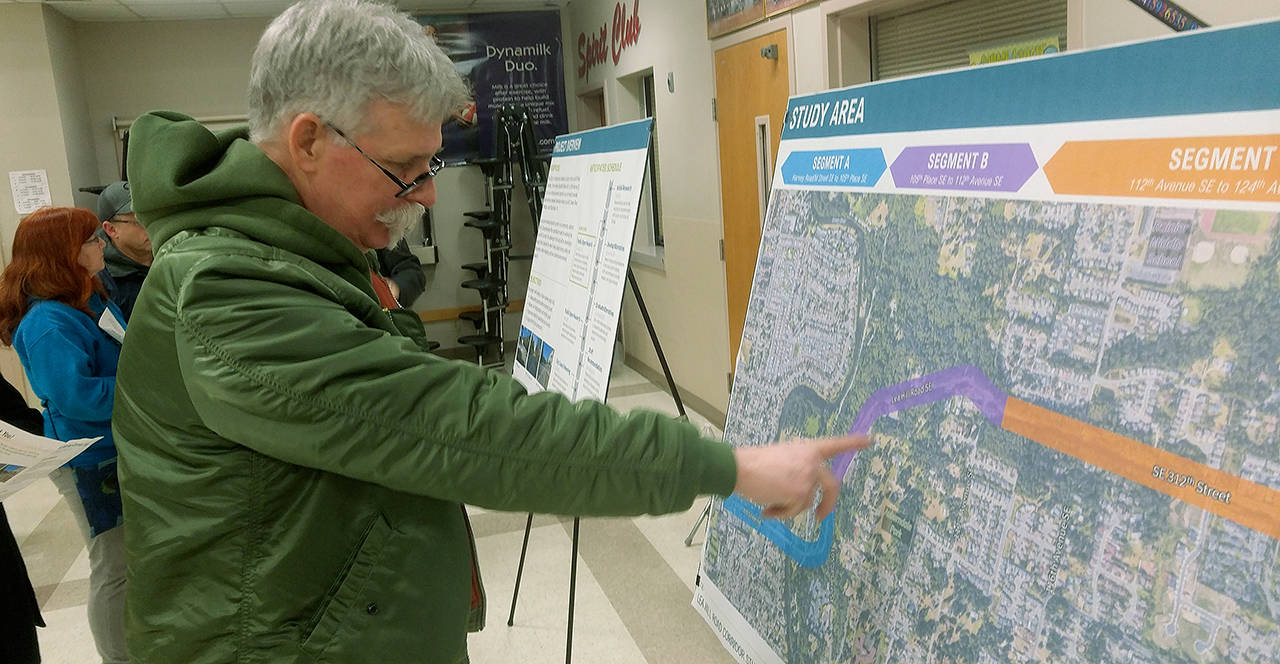Every day along the heavily traveled, narrow arterial from M Street Northeast and Harvey Road to 124th Avenue Southeast on Lea Hill, walkers and cars come too close to each other for comfort.
One issue that makes it especially dangerous, said Lea Hill resident Russ Campbell, is the lack of continuous sidewalks on 124th Southeast especially on the east side of the street.
“Have I walked this before? Yeah, we’ve dropped our car at Auburn City Imports and walked all the way home once or twice. And when you’re on that road, you don’t want to be on that road. You’re really worried. It’s a real problem,” Campbell said.
All it will take for pedestrians — among them the many students who come to and from Green River College – to suffer serious injury, or death, Campbell said, is for a motorist to take his mind off the street for a split second.
“It’s 35 miles-per-hour up there, and it’s too fast,” said Campbell’s wife, Jean Lix.
Last Wednesday, Jan. 16, city of Auburn engineering staff came to Rainier Middle School on Lea Hill to talk about the study they are conducting of the Lea Hill Corridor and to hear what people who regularly use the arterial say should be changed to improve the situation, everything from intersection fixes to lowering the speed limit.
They studied maps, talked to personnel and plastered helpful stickies on maps, with suggestions like: “need sidewalks along entire corridor;” “traffic calming measures;” “make intersection improvements;” “reduce congestion;” and “add bike lanes.”
“I’m constantly afraid I’m going to hit somebody, driving down that road,” said one man, who did not give his name.
Given Lea Hill’s growth now and into the future, said Ryan Vondrak, capital and construction engineering manager for the city, Auburn’s comprehensive plan has in fact indicated for years that this corridor needs to be widened and improved.
“The point of this exercise is to get public opinion and outreach for ideas to improve the corridor,” Vondrak said. “The information we gather tonight is going to help us develop alternatives we can analyze to determine the best path forward. That’s what we’re looking for. We will need to look for what funding opportunities we can get once we have a plan in place. It won’t be a plan to gather dust on the shelf once it’s completed.”
Concerned about the geological hazards of undercutting the hillside or widening the road, Bill Walker, who has lived on Lea Hill for 30 years, offered up an alternative.
The main problem with the Lea Hill area, Walker said, is the college traffic, which he estimates accounts for about 75 percent of the traffic the city has used as the basis for its calculations. His suggestion is that instead of trying to change the neighborhood, the city could remove all that traffic by simply diverting it to its own dedicated roadway coming off Highway 18, using a bridge that right now leads to a single residence.
“You could design that access such that the person who uses it would not be displaced,” Walker said. “In fact, when he comes out of his residence, stoplights and other traffic systems would stop traffic so he would proceed across his road as he does right now. Otherwise, it would be green, and people would just come into a new parking lot that would be built down below the hillside, and then you would use some sort of rail tram, not a cable, that would take people up to the top of the hill.”
The advantage of the rail, Walker continued, is it could be built on posts, so the actual effect to the ground would be minimal.
“It could also be expanded as they moved down the hill to service other buildings, so people could use it to get up and down the hill without trying to climb that 400-to-500-foot grade,” Walker said. “I’ve looked at the elevations and everything, and basically it would be dirt construction except for the on-ramps for the bridge. There would be virtually no other construction using concrete.”


